Applicability of a Supported Liquid Membrane in the Enrichment and Determination of Cadmium from Complex Aqueous Samples
Abstract
:1. Introduction
2. Materials and Methods
2.1. Chemicals
2.2. Instrumentation
2.3. SLM in Flat-Sheet Configuration Transport Experiments
2.4. Hollow Fibre Supported Liquid Membrane (HFSLM) Experiments
3. Results and Discussion
3.1. Composition of the Liquid Membrane
3.2. Effect of Chloride Concentration and pH of the Feed Phase
3.3. Application of the SLM to Determine Cd in Complex Liquid Samples
3.4. Preconcentration of Cadmium with a Hollow Fibre System
4. Conclusions
Acknowledgments
Author Contributions
Conflicts of Interest
References
- San Roman, M.F.; Bringas, E.; Ibanezez, R.; Ortiz, I. Liquid membrane technology: Fundamentals and review of its applications. J. Chem. Technol. Biotechnol. 2010, 85, 2–10. [Google Scholar] [CrossRef]
- Yurtov, E.V.; Koroleva, M.Y. Liquid membranes for extraction. Pet. Chem. 2014, 54, 581–594. [Google Scholar] [CrossRef]
- Kubis, L.; Engineering, B. Factors influencing transport through liquid membranes and membrane based solvent extraction. Transport 2001, 24, 509–518. [Google Scholar]
- Yang, X.J.; Fane, A.G.; Soldenhoff, K. Comparison of Liquid Membrane Processes for Metal Separations: Permeability, Stability, and Selectivity. Ind. Eng. Chem. Res. 2003, 42, 392–403. [Google Scholar] [CrossRef]
- Ahmad, A.L.; Shah Buddin, M.M.H.; Ooi, B.S.; Kusumastuti, A. Utilization of environmentally benign emulsion liquid membrane (ELM) for cadmium extraction from aqueous solution. J. Water Process Eng. 2015, 15, 26–30. [Google Scholar] [CrossRef]
- He, D.; Ma, M.; Zhao, Z. Transport of cadmium ions through a liquid membrane containing amine extractants as carriers. J. Membr. Sci. 2000, 169, 53–59. [Google Scholar] [CrossRef]
- Parhi, P.K. Supported Liquid Membrane Principle and Its Practices: A Short Review, Supported Liquid Membrane Principle and Its Practices: A Short Review. J. Chem. 2012, 2013, e618236. [Google Scholar] [CrossRef]
- Kocherginsky, N.M.; Yang, Q.; Seelam, L. Recent advances in supported liquid membrane technology. Sep. Purif. Technol. 2007, 53, 171–177. [Google Scholar] [CrossRef]
- Lozano, L.J.; Godínez, C.; de los Ríos, A.P.; Hernández-Fernández, F.J.; Sánchez-Segado, S.; Alguacil, F.J. Recent advances in supported ionic liquid membrane technology. J. Membr. Sci. 2011, 376, 1–14. [Google Scholar] [CrossRef]
- Pabby, A.K.; Swain, B.; Sastre, A.M. Recent advances in smart integrated membrane assisted liquid extraction technology. Chem. Eng. Process. 2017, 120, 27–56. [Google Scholar] [CrossRef]
- Mathiasson, L.; Jönsson, J.Å.; Mathiasson, L. Membrane extraction in analytical chemistry. J. Sep. Sci. 2001, 24, 495–507. [Google Scholar] [CrossRef]
- Msagati, T.; Chimuka, L.; Cukrowska, E. Sample preparation using liquid membrane extraction techniques. Water SA 2008, 34, 421–427. [Google Scholar]
- Marguí, E.; Van Grieken, R.; Fontàs, C.; Hidalgo, M.; Queralt, I. Preconcentration Methods for the Analysis of Liquid Samples by X-ray Fluorescence Techniques. Appl. Spectrosc. Rev. 2010, 45, 179–205. [Google Scholar] [CrossRef]
- Marguí, E.; Fontàs, C.; Hidalgo, M.; Queralt, I. Improved instrumental sensitivity for Cd determination in aqueous solutions using Wavelength Dispersive X-ray Fluorescence Spectrometry, Rh-target tube instrumentation. Spectrochim. Acta—Part B At. Spectrosc. 2008, 63. [Google Scholar] [CrossRef]
- Marguí, E.; Fontàs, C.; Van Meel, K.; Van Grieken, R.; Queralt, I.; Hidalgo, M. High-energy polarized-beam energy-dispersive X-ray fluorescence analysis combined with activated thin layers for cadmium determination at trace levels in complex environmental liquid samples. Anal. Chem. 2008, 80, 2357–2364. [Google Scholar] [CrossRef] [PubMed]
- López-López, J.A.; Mendiguchía, C.; Pinto, J.J.; Moreno, C. Liquid membranes for quantification and speciation of trace metals in natural waters. TrAC Trends Anal. Chem. 2010, 29, 645–653. [Google Scholar] [CrossRef]
- Parthasarathy, N.; Pelletier, M.; Buffle, J. Transport of lipophilic metal complexes through permeation liquid membrane, in relation to natural water analysis: Cu(II)-8-hydroxyquinoline complex as a model compound. J. Membr. Sci. 2010, 355, 78–84. [Google Scholar] [CrossRef]
- Slaveykova, V.I.; Parthasarathy, N.; Buffle, J.; Wilkinson, K.J. Permeation liquid membrane as a tool for monitoring bioavailable Pb in natural waters. Sci. Total Environ. 2004, 328, 55–68. [Google Scholar] [CrossRef] [PubMed]
- Bayen, S.; Worms, I.; Parthasarathy, N.; Wilkinson, K.; Buffle, J. Cadmium bioavailability and speciation using the permeation liquid membrane. Anal. Chim. Acta 2006, 575, 267–273. [Google Scholar] [CrossRef] [PubMed]
- Fontàs, C.; Salvadó, V.; Hidalgo, M. Separation and concentration of Pd, Pt, and Rh from automotive catalytic converters by combining two hollow-fiber liquid membrane systems. Ind. Eng. Chem. Res. 2002, 41, 1616–1620. [Google Scholar] [CrossRef]
- Parthasarathy, N.; Pelletier, M.; Buffle, J. Hollow fiber based supported liquid membrane: A novel analytical system for trace metal analysis. Anal. Chim. Acta 1997, 350, 183–195. [Google Scholar] [CrossRef]
- Bårdstu, K.F.; Ho, T.S.; Rasmussen, K.E.; Pedersen-Bjergaard, S.; Jönsson, J.A. Supported liquid membranes in hollow fiber liquid-phase microextraction (LPME—Practical considerations in the three-phase mode. J. Sep. Sci. 2007, 30, 1364–1370. [Google Scholar] [CrossRef] [PubMed]
- Fontàs, C.; Palet, C.; Salvadó, V.; Hidalgo, M. A hollow fiber supported liquid membrane based on Aliquat 336 as a carrier for rhodium(III) transport and preconcentration. J. Membr. Sci. 2000, 178. [Google Scholar] [CrossRef]
- Güell, R.; Fontàs, C.; Salvadó, V.; Anticó, E. Modelling of liquid-liquid extraction and liquid membrane separation of arsenic species in environmental matrices. Sep. Purif. Technol. 2010, 72. [Google Scholar] [CrossRef]
- Fontàs, C.; Anticó, E.; Salvadó, V.; Valiente, M.; Hidalgo, M. Chemical pumping of rhodium by a supported liquid membrane containing Aliquat 336 as carrier. Anal. Chim. Acta 1997, 346. [Google Scholar] [CrossRef]
- Fontàs, C.; Tayeb, R.; Tingry, S.; Hidalgo, M.; Seta, P. Transport of platinum(IV) through supported liquid membrane (SLM) and polymeric plasticized membrane (PPM). J. Membr. Sci. 2005, 263, 96–102. [Google Scholar] [CrossRef]
- Jean, E.; Villemin, D.; Hlaibi, M.; Lebrun, L. Heavy metal ions extraction using new supported liquid membranes containing ionic liquid as carrier. Sep. Purif. Technol. 2018. [Google Scholar] [CrossRef]
- Soko, L.; Chimuka, L.; Cukrowska, E.; Pole, S. Extraction and preconcentration of manganese(II) from biological fluids (water, milk and blood serum) using supported liquid membrane and membrane probe methods. Anal. Chim. Acta 2003, 485, 25–35. [Google Scholar] [CrossRef]
- Bhatluri, K.K.; Manna, M.S.; Ghoshal, A.K.; Saha, P. Separation of cadmium and lead from wastewater using supported liquid membrane integrated with in-situ electrodeposition. Electrochim. Acta 2017, 229, 1–7. [Google Scholar] [CrossRef]
- Bhatluri, K.K.; Manna, M.S.; Saha, P.; Ghoshal, A.K. Supported liquid membrane-based simultaneous separation of cadmium and lead from wastewater. J. Membr. Sci. 2014, 459, 256–263. [Google Scholar] [CrossRef]
- Irigoyen, L.; Moreno, C.; Mendiguchía, C.; García-Vargas, M. Application of liquid membranes to sample preconcentration for the spectrometric determination of cadmium in seawater. J. Membr. Sci. 2006, 274, 169–172. [Google Scholar] [CrossRef]
- Granado-Castro, M.D.; Galindo-Riaño, M.D.; Garcìa-Vargas, M. Separation and preconcentration of cadmium ions in natural water using a liquid membrane system with 2-acetylpyridine benzoylhydrazone as carrier by flame atomic absorption spectrometry. Spectrochim. Acta Part B At. Spectrosc. 2004, 59, 577–583. [Google Scholar] [CrossRef]
- Carletto, J.S.; Luciano, R.M.; Bedendo, G.C.; Carasek, E. Simple hollow fiber renewal liquid membrane extraction method for preconcentration of Cd(II) in environmental samples and detection by Flame Atomic Absorption Spectrometry. Anal. Chim. Acta 2009, 638, 45–50. [Google Scholar] [CrossRef] [PubMed]
- Peng, J.F.; Liu, R.; Liu, J.F.; He, B.; Hu, X.L.; Jiang, G.B. Ultrasensitive determination of cadmium in seawater by hollow fiber supported liquid membrane extraction coupled with graphite furnace atomic absorption spectrometry. Spectrochim. Acta Part B At. Spectrosc. 2007, 62, 499–503. [Google Scholar] [CrossRef]
- Fontàs, C.; Pont, N.; Hidalgo, M.; Salvadó, V. Separation and preconcentration of Cd(II) from chloride solutions using supported liquid membranes systems. Desalination 2006, 200. [Google Scholar] [CrossRef]
- Fontàs, C.; Salvadó, V.; Hidalgo, M. Selective enrichment of palladium from spent automotive catalysts by using a liquid membrane system. J. Membr. Sci. 2003, 223, 39–48. [Google Scholar] [CrossRef]
- Pont, N.; Salvadó, V.; Fontàs, C. Selective transport and removal of Cd from chloride solutions by polymer inclusion membranes. J. Membr. Sci. 2008, 318, 340–345. [Google Scholar] [CrossRef]
- Breembroek, G.R.M.; Witkamp, G.J.; van Rosmalen, G.M. Extraction of cadmium with trilaurylamine-kerosine through a flat-sheet-supported liquid membrane. J. Membr. Sci. 1998, 147, 195–206. [Google Scholar] [CrossRef]
- Fontàs, C.; Hidalgo, M.; Salvadó, V.; Anticó, E. Selective recovery and preconcentration of mercury with a benzoylthiourea-solid supported liquid membrane system. Anal. Chim. Acta 2005, 547, 255–261. [Google Scholar] [CrossRef]
- Alonso, M.; López-Delgado, A.; Sastre, A.M.; Alguacil, F.J. Kinetic modelling of the facilitated transport of cadmium (II) using Cyanex 923 as ionophore. Chem. Eng. J. 2006, 118, 213–219. [Google Scholar] [CrossRef]
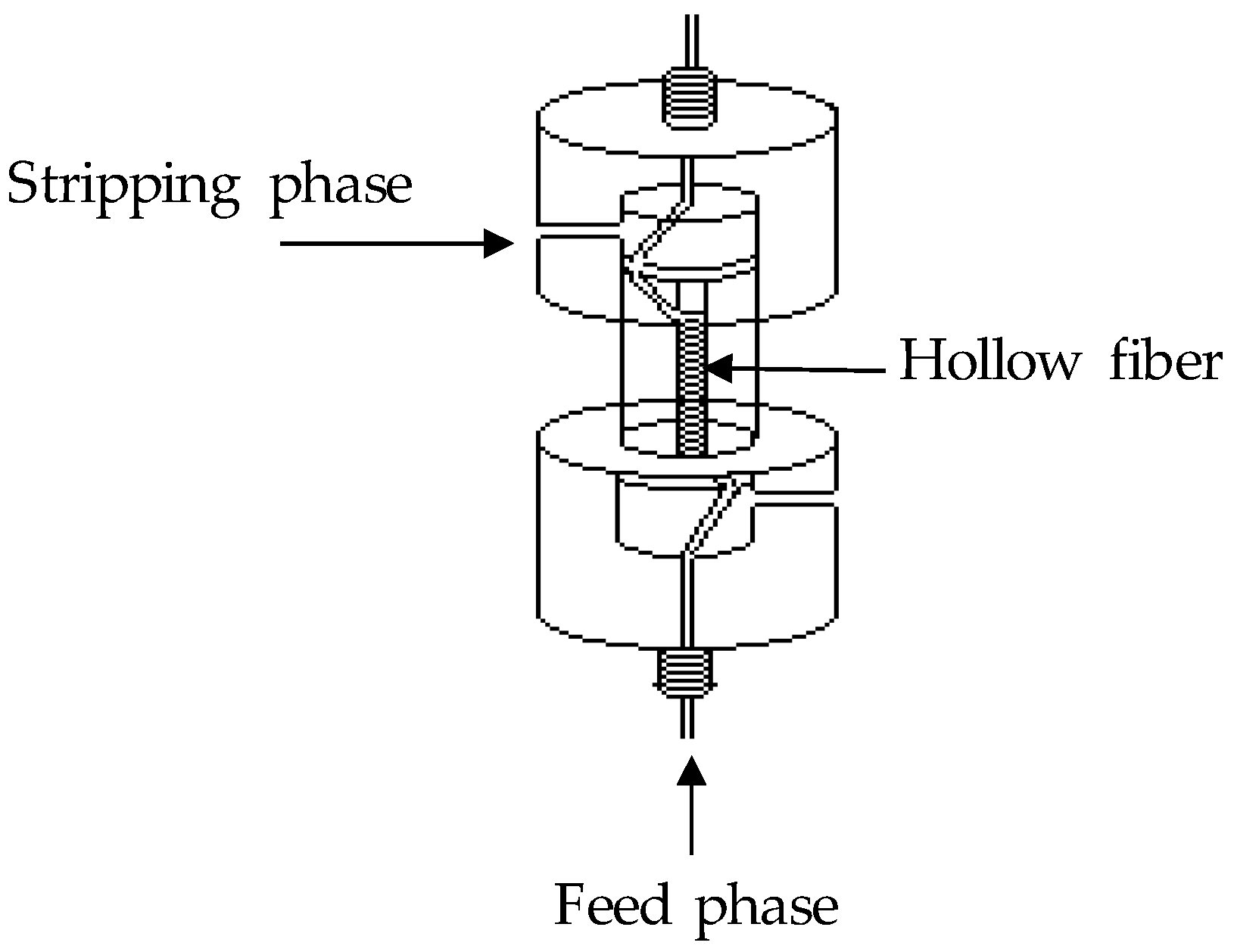

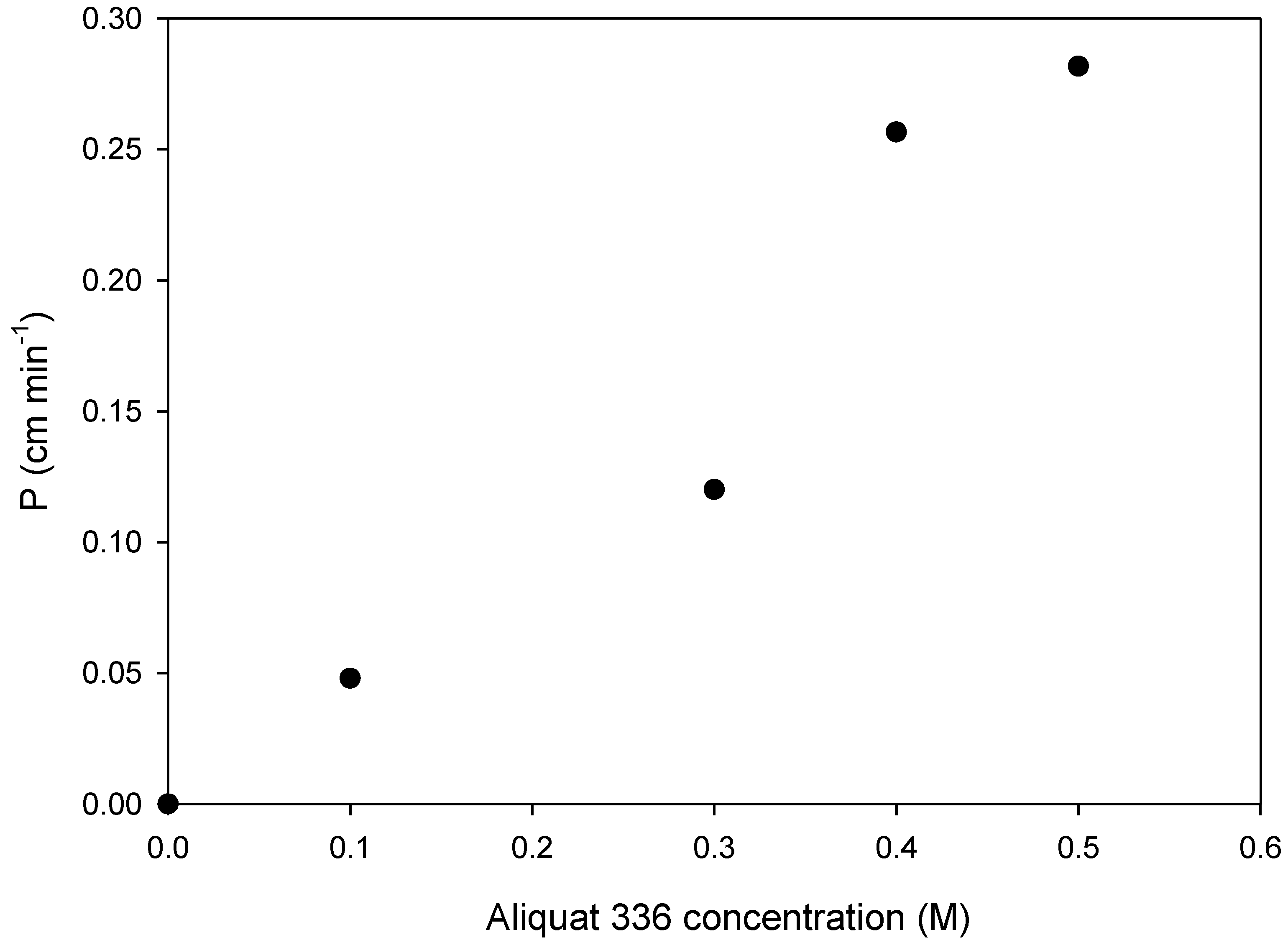
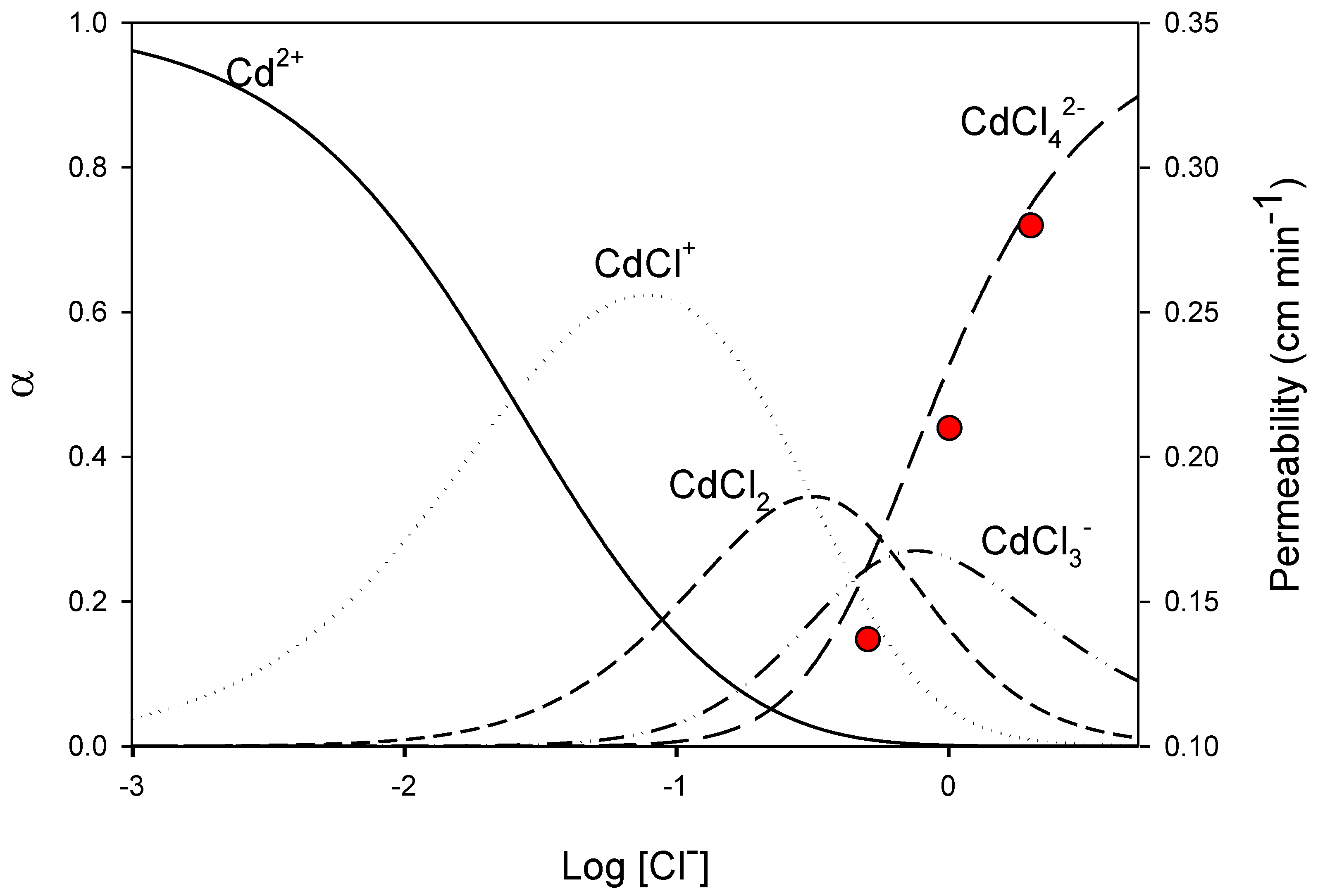
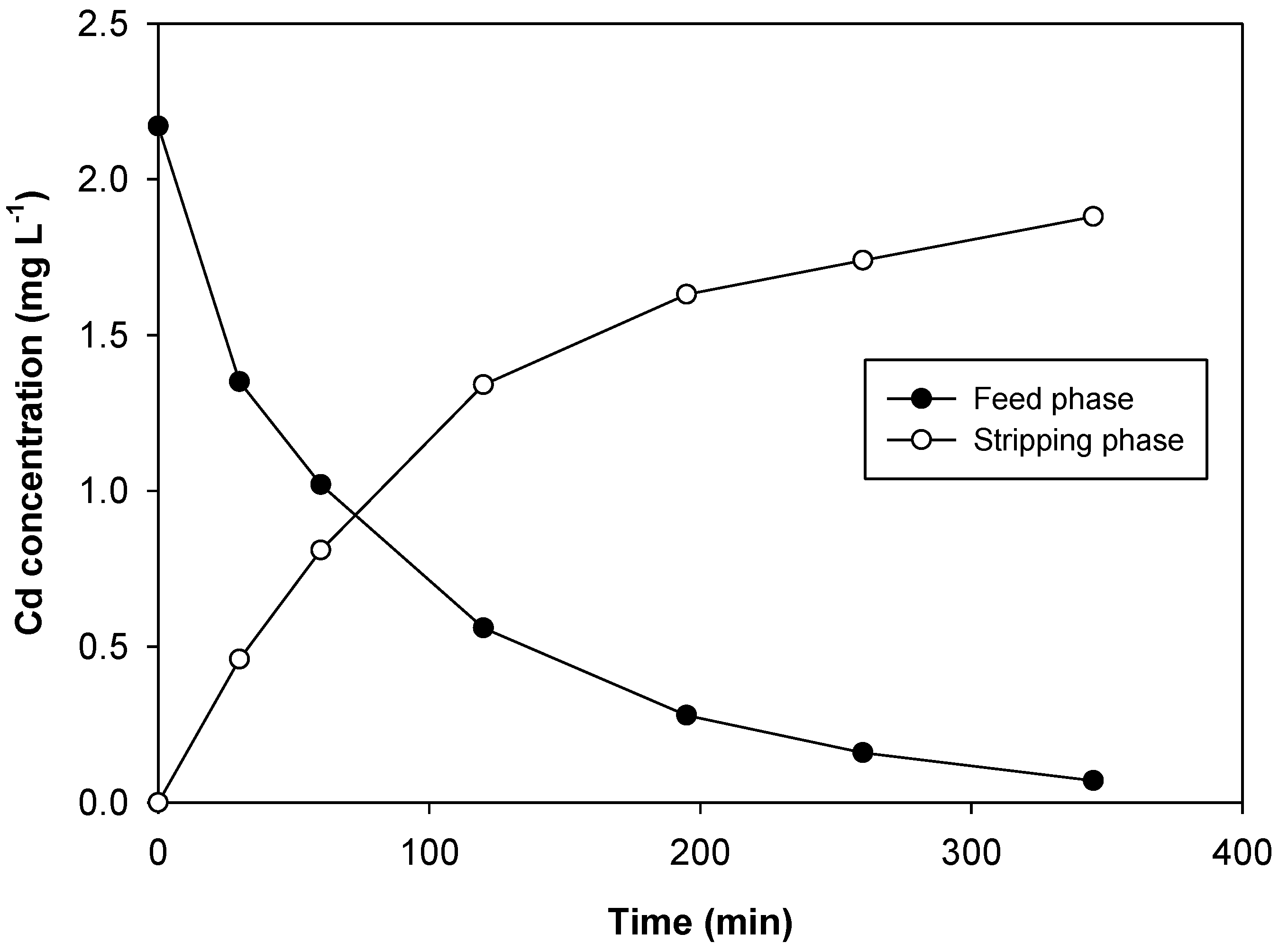
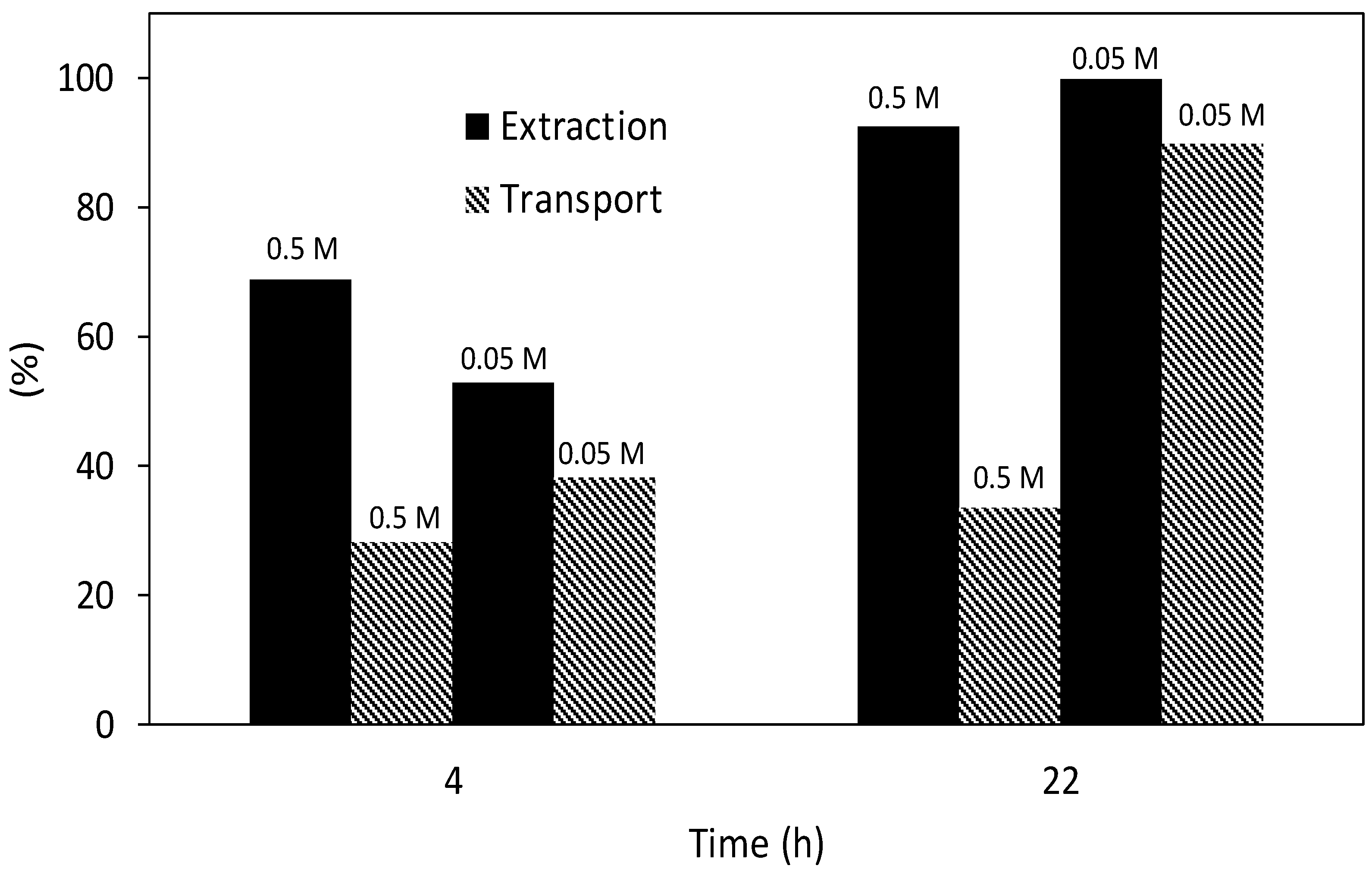
| Organic Solvent | P (cm min−1) |
|---|---|
| Decaline | 0.282 |
| Dihexylether | 0.263 |
| Dodecane (4% dodecanol) | 0.252 |
| Cumene | 0.356 |
| Metal | (Metal) Feed, 0 (mg L−1) | TE (%) (2 h/24 h) |
|---|---|---|
| Cd | 0.486 | 100/100 |
| Cu | 9.622 | 0/2 |
| Ni | 9.209 | 0/0 |
| Pb | 9.169 | 0/21 |
| Sample | Cd Added (mg L−1) | Cd Stripping (24 h) (mg L−1) | TE (%) (24 h) |
|---|---|---|---|
| Seawater | 0.026 | 0.439 | 84.4 |
| 0.019 | 0.377 | 99.2 |
© 2018 by the authors. Licensee MDPI, Basel, Switzerland. This article is an open access article distributed under the terms and conditions of the Creative Commons Attribution (CC BY) license (http://creativecommons.org/licenses/by/4.0/).
Share and Cite
Pont, N.; Salvadó, V.; Fontàs, C. Applicability of a Supported Liquid Membrane in the Enrichment and Determination of Cadmium from Complex Aqueous Samples. Membranes 2018, 8, 21. https://doi.org/10.3390/membranes8020021
Pont N, Salvadó V, Fontàs C. Applicability of a Supported Liquid Membrane in the Enrichment and Determination of Cadmium from Complex Aqueous Samples. Membranes. 2018; 8(2):21. https://doi.org/10.3390/membranes8020021
Chicago/Turabian StylePont, Núria, Victòria Salvadó, and Clàudia Fontàs. 2018. "Applicability of a Supported Liquid Membrane in the Enrichment and Determination of Cadmium from Complex Aqueous Samples" Membranes 8, no. 2: 21. https://doi.org/10.3390/membranes8020021
APA StylePont, N., Salvadó, V., & Fontàs, C. (2018). Applicability of a Supported Liquid Membrane in the Enrichment and Determination of Cadmium from Complex Aqueous Samples. Membranes, 8(2), 21. https://doi.org/10.3390/membranes8020021






